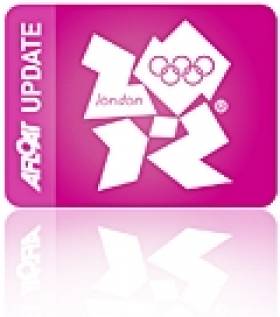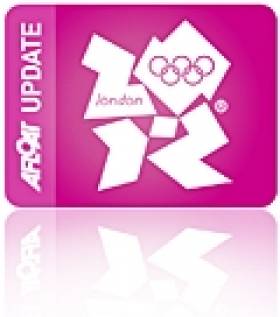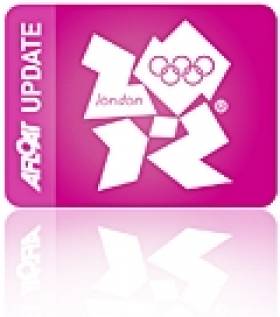Displaying items by tag: Olympic 2012
Murphy, O'Leary and Burrows Back in Action in Miami
#US SAILING – This weekend the Irish Olympic Star sailing team aka Peter O'Leary and David Burrows along with Annalise Murphy in the Laser Radial is back in action in Miami at the first ISAF Sailing World Cup Regatta of 2012. US SAILING's Rolex Miami OCR will kick the 2012 calendar off following a busy 2011 that saw ten World Champions crowned at the Perth 2011 ISAF Sailing World Championships.
Running from 22-28 January at Biscayne Bay, Florida, USA, the Rolex Miami OCR will feature all of the Olympic events as teams ramp up preparations for the London 2012 Olympic Sailing Competition.
Robert Scheidt and Bruno Prada (BRA) will be the pair to beat in the Star class following their gold medal performance in Perth 2011. The pair also dominated the 2010-2011 ISAF Sailing World Cup winning four of the five regattas they sailed in and are reigning champions in Miami.
With a winning margin of 49 points over Fredrik Loof and Max Salminen (SWE) at the 2011 regatta, a repeat performance would give the Brazilian World Champions a great start to their World Cup campaign.
In a fleet of 31-boats Loof and Salminen will join the Brazilians in Miami, as will Perth 2011 bronze medallists Mark Mendelblatt and Brian Fatih (USA) and 2009-2010 ISAF Sailing World Cup Star champions Eivind Melleby and Petter Morland Pedersen (NOR).
Ireland's Peter O'Leary and David Burrows who are now certain of their Olympic slot for London will be attemptin to move up a gear and challenge the champions with under 200 days to the Olympic regatta itself.
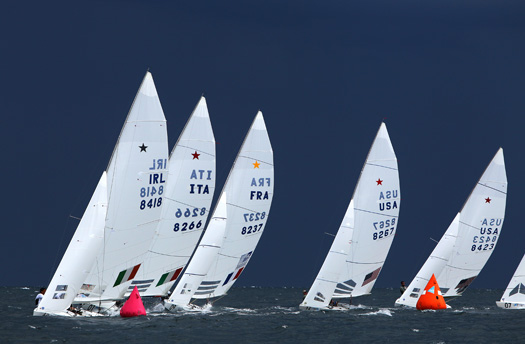
O'Leary and Burrows are back on the Olympic circuit this wekend in Miami, Florida – Photo: Richard Langdon
In the Laser Radial Lijia Xu (CHN) will look to continue her good start to her Sailing World Cup campaign after victory at Sail Melbourne. The World #42 won Sail Melbourne after a dominating display following seven top three finishes during the regatta in the competitive 25-boat fleet. But the 2008 Olympic bronze medallist and former Laser Radial World Champion will find Miami a harder nut to crack with 59 sailors registered to compete.
Among the fleet is World #1 Evi Van Acker (BEL), Perth 2011 ISAF Sailing World Championships Laser Radial gold medallist Marit Bouwmeester and Perth 2011 bronze medallist and winner of the 2011 Rolex Miami OCR Paige Railey (USA).
Dun Laoghaire's Annalise Murphy fresh from her sixth in Perth in December is competing and seeking further progress for London.
Bouwmeester is going for a third consecutive ISAF Sailing World Cup title after a six point victory over Veronika Fenclova (CZE) in 2009-2010 and a one point win over Van Acker in 2010-2011. But after one regatta Bouwmeester sits in 15th position with Xu leading the way followed by Tuula Tenkanen (FIN) and Krystal Weir (AUS).

Annalise in action in Perth. She races this weekend in Miami. Photo: Richard Langdon
With 81 entries the Laser fleet is the largest at the Rolex Miami OCR. World #4 Bruno Fontes (BRA) is the highest ranked sailor competing World #5 Julio Alsogaray (ARG) and Beijing Olympic gold medallist Paul Goodison (GBR) set to join him on the starting line.
In the Men's RS:X 14 sailors will compete for ISAF Sailing World Cup points with last year's World Cup runner up Nick Dempsey (GBR) set to line up. And in the Women's fleet, 13 windsurfers will compete.
A competitive 16-boat fleet will line up in the Women's 470. Amanda Clark and Sarah Lihan (USA) and Kathrin Kadelbach and Friederike Belcher (GER) sailed at Sail Melbourne and registered early World Cup points. The Americans finished third whilst the Germans came fifth. Another good performance from either crew will give them a superb start to the 2011-2012 campaign.
Joining the American and German crews will be World #2 Hannah Mills and Saskia Clark (GBR). Having already been selected to represent Great Britain for the London 2012 Olympic Sailing Competition the pressure of qualification is off the girls and they will get some valuable competition time in Miami.
Israel's Gil Cohen and Vered Bouskila and the Netherlands Lisa Westerhof and Lobke Berkhout will also sail following strong performances at Perth 2011.
The Men's 470 fleet welcomes 24 crews to Miami including Perth 2011 gold medallists and World #1 pair Mathew Belcher and Malcolm Page. The Australians finished second behind Stuart McNay and Graham Biehl (USA) at the opening ISAF Sailing World Cup Regatta, Sail Melbourne, and are looking to defend the World Cup crown they won by 19 points last year.
World #3 Panagiotis Mantis and Pavlov Kagialis (GRE), World #7 Gideon Kliger and Eran Sela (ISR) and World #8 Luca Calabrese and Juan De La Fuente (ARG) are also set to sail.
Thirteen American Finn sailors make up half of the 26-boat fleet. World #6 Zach Railey (USA) will be the favourite to take the title with only Brendan Casey (AUS) and Caleb Paine (USA) the other sailors in the top 25 of the world's Finn sailors.
2010-2011 ISAF Sailing World Cup 49er Champions Nico Delle-Karth and Nikolaus Resch (AUT) begin their World Cup campaign and will be joined by World #4 pair Allan Norregaard and Peter Lang (DEN) and the American team of Erik Storck and Trevor Moore whose dreams of world championship medals were shattered in Perth when their rudder broke in the Medal Race.
The Paralympic Classes also commence sailing with 29 registered 2.4mR entries, seven SKUD-18 and 11 Sonar entries.
Women's Match Racers enjoy a practice day on 22 January before competition for all the fleets kicks off on 23 January.
Irish Sailors Prepare for Second Leg of Olympic Trials
The promising results from Holland included Peter O'Leary and David Burrows who were fourth overall in the Star class. Annalise Murphy was ninth overall in the Laser Radial and Ryan Seaton and Matt McGovern were fifth overall in the 49er dinghy.
Podcast with Olympic team manager James O'Callaghan
755 Entries, 62 nations, 1072 athletes, 320 coaches this is the biggest sailing world cup regatta ever. Every sailor with Olympic ambition is targeting a performance this week on the Olympic waters.The Irish sailors are no different but have the extra incentive of knowing the event counts as selection for the Irish Olympic team. Last week at the World Cup in Holland, the Irish Sailing squad performed: all made the Medal race final and both the Radial and the 49er won the Medal race. This week will be a step up in standard with the majority of countries using this event to assess their sailors Olympic potential.
In the Star class Peter O'Leary and David Burrows will be hoping to defend the title O'Leary won last year, Annalise Murphy will be targeting another medal race final and Ryan Seaton and Matt McGovern would be pleased with another top performance.
No Racing Puts the Pressure on Final Day at Largs
More than five hours of frustrating drifting on the Clyde off Largs today proved to be in vain for the sailors awaiting racing at the Laser Radial World Championships.
The mirror like waters were only occasionally ruffled by light airs from conflicting directions, and only – as the race officers' version of Murphy's Law would have it – as the appropriate signals were made, was there anything close to a breeze.
Sari Multala, Finland's defending world champion goes into the final day of scheduled racing with a lead of seven points over Marit Bouwmeester (NED).
It will be an interesting finale. Forecasts conflict as to how much or how little breeze there will be and the opinions seem to be towards either extreme.
Even if there are three races for the Women's gold fleet there can only be one discarded result and Bouwmeester has not finished outside the top ten so far, whilst Multala has a weighty 49th from Race 4 as her throwout.
In the Men's fleet it is champion Marcin Rudawski (POL), also the defending 2009 who enters the last day at Largs with a six points lead and only a seventh place as his discard, whilst fellow Pole Wojciech Zemke lies second and the USA's impressive 16 year old Mitchell Kiss lies third.
Standings: Laser Radial Womens World Championships
Gold Flight Overall After race 6 Inc. 1 discard
1 S Multala (FIN) 4,3,1,(49),2,5, Nett = 15pts,
2 M Bouwmeester (NED) 2,1,5,(7),6,8,= 22pts,
3 P Railey (USA) 3,1,4,16,(17),3 = 27pts,
4 S Steyaert (FRA) 23,4,1,3, 15,4, = 27pts,
5 T Drozdovskaya (BLR) 1,5,14,3,(32),13, = 36pts,
6 T Mihelic (CRO) 15,8,3,8,(35),6, = 40pts,
7 A Tunnicliffe (USA) 1,2,37,(49),5,2, = 47pts,
8 E Van Acker (BEL) 6,11,(21),14,1,15, = 47pts,
9 G Scheidt (LTU) 13,19,2,4,(40),11, = 49pts,
10 M de Kerangat (FRA) 18,7,15,5,(19),10 = 55pts,
Laser Radial Mens World Championship 2010
Overall After Race 6 Inc. 1 Discard
1 M Rudawski (POL) 1,2,1,1,1,(7), Nett = 6pts,
2 W Zemke (POL) 1,1,2,1,7,(OCS[48]), = 12pts,
3 M Kiss (USA) 4,10,3,(29),2,2, = 21pts ,
4 B Koppelaar (NED) 9,4,1,(37),4,4, = 35pts,
5 I Kim (KOR) ,5,8,4,2,(32),16, = 35pts,
Sari Multala (FIN): "It was pretty strange. I found the decision to cancel when they did a little strange but of course it is always frustrating to sit around for the whole day. It is nice to be going into the last day with a seven points lead, but I still have to sail well because it looks we will only get one discard so every race is going to count. But almost everyone is in the same position. Marit who is behind me is in a good position as she has no bad races. It would be nice to get some more races for sure. But for me it will be about managing the risks and a top 5 result could be enough."
Marit Bouwmeester (NED) "It is a shame because it is always better to get racing. I think it will be all down to tomorrow I think it is better for everyone to get more races in. I am pretty happy with the way it has gone and I don't think I could have gone any better. I'm not too worried about what the weather does tomorrow but I do like to sail in strong winds."
Tatiana Drozdovskava (BLR): "It is very strange weather out there, no wind at all, just a mirror for five hours. For me I am fairly happy with my position, but more races tomorrow would be good."
Ali Young (GBR): "It was frustrating, but there was nothing that the race management could do. It was just when we started to get towed in that there was some wind.
It has gone alright for me. I have managed to stay fairly consistent, so hopefully we will get three races in tomorrow and that would finish it off nicely. I am happy with how things have gone so far. We have had some very tricky conditions and so I am pleased to have been able to keep consistent with my starts and build my races from there.
There are pretty conflicting forecasts but it would be just good to get some more races in. It will be shifty here no matter where the wind comes from, that is what we have seen all week. You know it will be shifty because there is so much land around.
We did not see any easterlies when we trained here and have now raced in that, but the training we did was valuable even just to get your head into what it is like."
Racing Schedule
Laser Radial Women's and Men's World Championships
Qualification Series Friday 9th to Sunday 11th July
Final Series Monday 12th to Wednesday 14th July
Prize Giving Wednesday 14th July
Murphy Lies 20th in Laser Radial Worlds
Largs, Scotland Sunday 11th July: With a second place from today’s only race on the Clyde off Largs, Finland’s reigning champion Sari Multala emerges at the top of the leaderboard of the Laser Radial World Championships as the fleet move into the Finals phase. Ireland's Annalise Murphy lies 20th and Tiffany Brien 37th.
Holland’s Marit Bouwmeester was a woman in a hurry despite the fading breeze.
She staged a great comeback after lying very deep in the fleet after struggling on the very difficult opening beat, but making great gains on the downwind legs she rallied to sixth place which keeps the world ranked two sailor just four points behind Multala.
Not only was Bouwmeester quick and smart enough in the testing, shifty and increasingly fluky conditions, with the breeze dying from 12 to 5 knots, to rescue a solid finish but the Dutch sailor was ashore and tidied away sufficiently rapidly to be just ready on cue to watch the start of her nation’s football world cup final challenge.
Patience was required over the duration of what proved to be a very long day ashore, with successive postponements required from morning until the strong westerly breeze subsided to allow racing. It was only at 1700hrs that both Men’s and Women’s fleets had their warning signal finally scheduled.
The breeze died progressively leaving big differences in strength across the race tracks on both race areas and, once again, shifts in wind direction offered opportunities for big gains and losses.
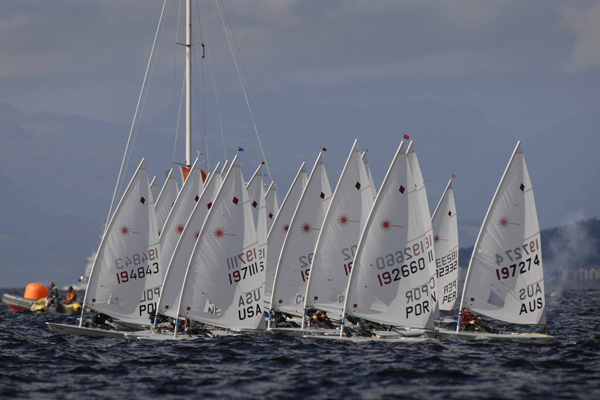
Photo: Mark Turner
Evie Van Acker (BEL) started off the pin end of the start line and was able to get into the best of the early wind pressure, leading the yellow flight race from start to finish with Multala second and Poland’s Joanna Maksymiuk taking third.
While the yellow fleet got away with perhaps the better breeze, the blue fleet suffered a big left wind shift immediately after the start and then a big shift to the right at the top end of their beat. But the most important challenge was to knit together the strands of best wind pressure.
Singapore’s Elizabeth Yin won the blue flight race ahead of Spain’s Fatima Reyes, while fifth place for Mexico’s Tania Elias Calles Wolf ensures her consistent string of scores remains intact and she now lies third.
Largs has proven a testing challenge in brisker winds, but with the breezes now expected to drop to the lower end of the scale for the second half of the regatta, perhaps it is only likely to get more difficult. In a very high standard of fleet the stakes get higher and higher.
The host country’s Skandia Team GBR sailors had a mixed day. Ali Young finished in 28th but holds 12th overall, whilst Scotland’s Charlotte Dobson’s 20th leaves her lying 23rd overall.
In the Men’s championship Poland’s Marcin Rudawski scored his fourth win from five starts to sit one point clear of his compatriot Wojciech Zemke, while Holland’s Ben Kopelaar lies third.
Laser Radial World Championships, Largs, Scotland
Women's Overall after Day 3, including one discard.
1 S Multala (FIN) 4,3,1,(49),2 = 10pts
2 M Bouwmeester (NED) 2,1,5,(7), 6 = 14pts
3 T Elias Calles Wolf (MEX) 4,(10),7,5,5 = 21pts
4 S Steyaert (FRA) (23), 4, 1, 3, 15 = 23pts
5 T Drozdovskaya (BLR) 1,5,14,3,(32) = 23pts
6 P Railey (USA) 3,1,4,16,(18) = 24pts
7 V Fenclova (CZE) 17,5,3,(22),3 = 28pts
8 S Lihan (USA) 8,3,10,10,(25) = 31pts
9 E Van Acker (BEL) 6,11,(21),14,1 = 32pts
10 T Mhelic (CRO) 15,8,3,8,(35) = 34pts
Men Overall after Day 3, including one discard.
1 M Rudawski (POL) 1,(2),1,1,1 Nett = 4pts
2 W Zemke (POL) 1,1,2,1,(7.0) = 5pts
3 B Koppelaar (NED) 9,4,1,(37),4 = 18pts
4 Y Hummel (NED) 9,1,(24),2,7 = 19pts
5 M Kiss (USA) 4,10,3,(29),2 = 19pts
Quotes:
Evie Van Acker (BEL): “I had a good start at the pin end of the line. There were not so many people there and I was able to pull out a little bit. I tacked again to get the fresher pressure and then I was leading at the first mark from Laura Baldwin and Sari Multala behind her.”
“Downwind I was really fast and on the right side with the current. When the wind dropped and dropped the current became more and more important and from there I was just defending.”
Marit Bouwmeester (NED): “It was big funny, and very difficult at times. I made a good recovery, mostly on the downwinds.”
Sari Multala (FIN): “ I was starting in the middle and had clear air and so could choose where I wanted to go. There looked to be some pressure on the right and in fact the people who were in it actually did not seem to get very far in it. So actually I got into the first pressure from the left, and there were actually a couple of boats from the far left who did better. So both the sides were OK. On the run I got from third to second where I stayed. I needed a good race and got one.”
I had hoped we could have got out a little earlier because really it was not so strong and it would have been good to get a second race.
Charlotte Dobson (GBR): “It was very patchy off the start line and I managed to miss the first puff and then struggled from there but managed to catch up from there, and had a good last beat. But really with the forecast we have I think racing pretty much starts all over again”
Racing Schedule
Laser Radial Women’s and Men’s World Championships
Qualification Series Friday 9th to Sunday 11th July
Final Series Monday 12th to Wednesday 14th July
Prize Giving Wednesday 14th July



























